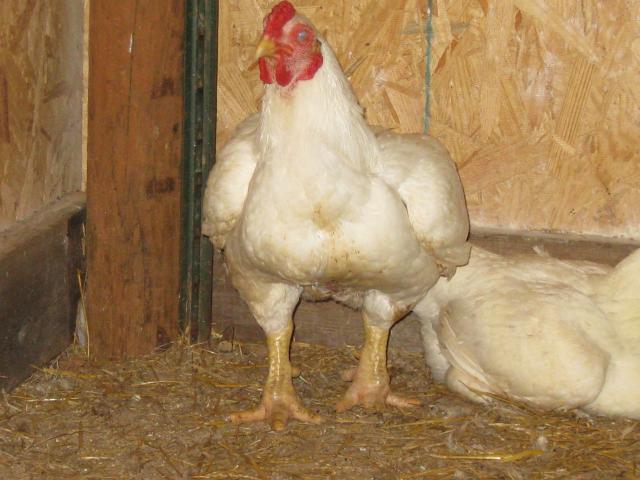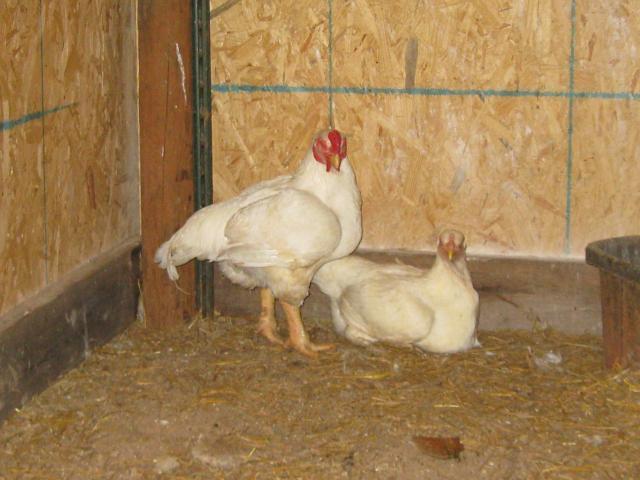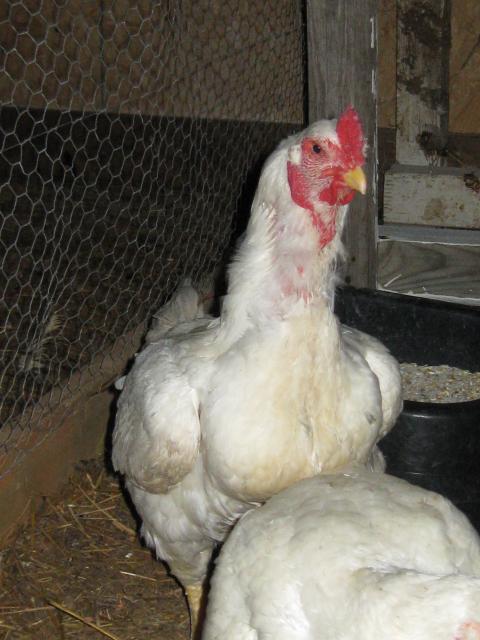I have been working on a broiler project too. Sorta from scratch from what i was able to get my hands on. I got two dark cornish hens with my maran roo. I plan on keeping some of the hens for dark eggers and the males for meat. I have my first batch growin out now. I plan on keeping a couple hens for the breeding project and I also want to end up with a maranxdark cornish roo to breed back cornish hens. In the future I hope to introduce a pure Cornish roo and kinda grow with. My dark cornish are hatchery stock nothing special. I would like to get eggs from a breeder that has better stock. So far I have a SLW X Dark Cornish Hen i hatched when the cornish first started laying. She looks just like the cornish except silver laced instead of Gold laced. Very nice breast on her too. The maranX Cornish are very large bigger than the cochins and pure marans same age. Beautiful big breast on them too. Im excited about them. Plus I read that the french developed the marans for good taste too. They are dual purpose in France.
Navigation
Install the app
How to install the app on iOS
Follow along with the video below to see how to install our site as a web app on your home screen.
Note: This feature may not be available in some browsers.
More options
You are using an out of date browser. It may not display this or other websites correctly.
You should upgrade or use an alternative browser.
You should upgrade or use an alternative browser.
Starting my own meat birds dark cornish and cross with white rock
- Thread starter maf2008
- Start date
HOW COOL....! I love progects like this...I wish you luck on everything you set your mind on...

have you kept any writen reconds? hatch weights? weight at 2, 8, 14 weeks? with help of guys like, doing your home grown base broilers I am trying to build a scientific Data Base that will help future breeders...so any notes you can take will be of great help thank you...

have you kept any writen reconds? hatch weights? weight at 2, 8, 14 weeks? with help of guys like, doing your home grown base broilers I am trying to build a scientific Data Base that will help future breeders...so any notes you can take will be of great help thank you...
- May 13, 2008
- 10,684
- 193
- 321
I am involved in the same type program so I will be following this and maybe posting some of my results.
AL
AL
Quote:
I wouldn't say it's too much info, but in a free-range situation, some of it just isn't going to be possible.
I'm afraid my records won't be as detailed or scientific as yours. I free-range all of my birds, and there's no way I can track who eats how much. I can only track how much feed they go through all together. Since I have mixed breed layers, as well as the pure breeds I'll me using for the meat bird breeding, this presents some difficulties in feed estimates. I'll be confining the roosters that I don't want to use for breeding, (if I still have any additional roos at that time) then confining the hens I want eggs from about a month after taking out the unwanted roos. When I want eggs from certain hens, I move them at night to a "private" pen, then after I get their eggs for the day, I let them out to range with the rest of the flock. Then repeat every night until I have as many eggs I want from them. That way they still get the benefits of free ranging foraging, and keep the fertility up, because the roos are ranging free, too. And they don't go too nuts from being suddenly confined.
When the eggs hatch, I can tell you my hatch rate, how many chicks I have, but I don't vent sex, so how many males, how many females, will have to wait until they're old enough to tell apart.
At some point, I'll have the meat chicks and layer flock separated for a few days, and I'll be able to see how much feed the layers and roos consume alone. Then I can subtract that amount from the daily consumption to get an estimate of how much the meat birds eat.
I don't trap-nest my hens, and they are, as I said, free range, so the weights of eggs at precise ages is not going to be something I can do. Unless I can get the hens to sign their eggs for me, I won't have any idea who laid what. Nor do I want to. I'm not concerned about exact egg weight, or hatch weight, either.
What I want to know is what cross yields a reasonably good butcher weight by around 10-16 weeks. By reasonable, I mean 4 lbs or more, dressed.
My initial test breeding, which wasn't what I actually wanted, as I didn't have any dark Cornish roos then, was Brahma roo over dark Cornish hen. The hens were undersized, (from Murray McMurray hatchery) but the Brahma roos were good breeder stock. There were 4 cockerels from that test, butchered at somewhere around 20-25 weeks. Somewhat older than I want to butcher, but that was when I got around to it. Two dressed out to over 6 lbs, the other two over 7 lbs. That's a lot heavier than dual purpose birds usually end up, by that age. They had good sized breasts, not bony like the typical dual purpose roo, and were delicious. I didn't keep any records, I wasn't really expecting anything all that great. I was just sort of playing around.
Others I've raised, before I decided to try breeding for meat, were much scrawnier and weighed maybe 3 lbs dressed.
In the spring, I'll be using dark Cornish roos over several other breeds of hens, including Brahma, and Delaware, what ever other breeds I can acquire by then. I'm hoping to have Buckeye, Salmon Faverolle, and Dorking. I have one Dorking hen, but she's sort of undersized, so I'd like some more. If I get a chance to get some good quality hens of others breeds that might be suitable, I'll try those, too.
My records will include:
fertility rate of eggs
hatch rate (number of eggs, number of live hatches)
approximate amount of feed from hatch to butcher
butcher age
live weights at:
8 weeks
12 weeks
16 weeks and 20 weeks (if not butchered before then)
and weight when they are butchered, at whatever age
dressed weight (I do not skin, or throw away any edible parts such as wings, backs, etc. so weight will be the whole chicken, with neck, skin, gizzard, heart, and liver)
flavor (Though that's highly subjective, and a personal preference)
tenderness
number and gender of birds butchered
number and gender of birds kept for breeding or other purpose
which birds were crossed for any given group
ages and maybe the weights of the breeders
I'll be able to see how many eggs my breeding hens are laying during the times they are confined for me to collect the eggs, but not how many each individual hen lays, because they'll be in a group pens, not caged individually.
If any of that will be helpful, then you're welcome to it. I won't be ready to start breeding until next spring, at the earliest. Possible exception is C. roo/Brahma hen crosses, maybe as soon as this winter, if all goes well.
I have some dark Cornish roos now. They aren't breeder stock, but good sized, and bigger than the MMH Cornish. That's the best I've been able to find. I'm still looking, and if I can get breeder stock at some point, so much the better.
If there's somebody with SQ dark Cornish, with rejects for long legs or tails, please email me. I don't care if the legs are long, I'm not showing them, and they breed easier. I don't care about the tails either, because I'm not showing them.
I wouldn't say it's too much info, but in a free-range situation, some of it just isn't going to be possible.
I'm afraid my records won't be as detailed or scientific as yours. I free-range all of my birds, and there's no way I can track who eats how much. I can only track how much feed they go through all together. Since I have mixed breed layers, as well as the pure breeds I'll me using for the meat bird breeding, this presents some difficulties in feed estimates. I'll be confining the roosters that I don't want to use for breeding, (if I still have any additional roos at that time) then confining the hens I want eggs from about a month after taking out the unwanted roos. When I want eggs from certain hens, I move them at night to a "private" pen, then after I get their eggs for the day, I let them out to range with the rest of the flock. Then repeat every night until I have as many eggs I want from them. That way they still get the benefits of free ranging foraging, and keep the fertility up, because the roos are ranging free, too. And they don't go too nuts from being suddenly confined.
When the eggs hatch, I can tell you my hatch rate, how many chicks I have, but I don't vent sex, so how many males, how many females, will have to wait until they're old enough to tell apart.
At some point, I'll have the meat chicks and layer flock separated for a few days, and I'll be able to see how much feed the layers and roos consume alone. Then I can subtract that amount from the daily consumption to get an estimate of how much the meat birds eat.
I don't trap-nest my hens, and they are, as I said, free range, so the weights of eggs at precise ages is not going to be something I can do. Unless I can get the hens to sign their eggs for me, I won't have any idea who laid what. Nor do I want to. I'm not concerned about exact egg weight, or hatch weight, either.
What I want to know is what cross yields a reasonably good butcher weight by around 10-16 weeks. By reasonable, I mean 4 lbs or more, dressed.
My initial test breeding, which wasn't what I actually wanted, as I didn't have any dark Cornish roos then, was Brahma roo over dark Cornish hen. The hens were undersized, (from Murray McMurray hatchery) but the Brahma roos were good breeder stock. There were 4 cockerels from that test, butchered at somewhere around 20-25 weeks. Somewhat older than I want to butcher, but that was when I got around to it. Two dressed out to over 6 lbs, the other two over 7 lbs. That's a lot heavier than dual purpose birds usually end up, by that age. They had good sized breasts, not bony like the typical dual purpose roo, and were delicious. I didn't keep any records, I wasn't really expecting anything all that great. I was just sort of playing around.
Others I've raised, before I decided to try breeding for meat, were much scrawnier and weighed maybe 3 lbs dressed.
In the spring, I'll be using dark Cornish roos over several other breeds of hens, including Brahma, and Delaware, what ever other breeds I can acquire by then. I'm hoping to have Buckeye, Salmon Faverolle, and Dorking. I have one Dorking hen, but she's sort of undersized, so I'd like some more. If I get a chance to get some good quality hens of others breeds that might be suitable, I'll try those, too.
My records will include:
fertility rate of eggs
hatch rate (number of eggs, number of live hatches)
approximate amount of feed from hatch to butcher
butcher age
live weights at:
8 weeks
12 weeks
16 weeks and 20 weeks (if not butchered before then)
and weight when they are butchered, at whatever age
dressed weight (I do not skin, or throw away any edible parts such as wings, backs, etc. so weight will be the whole chicken, with neck, skin, gizzard, heart, and liver)
flavor (Though that's highly subjective, and a personal preference)
tenderness
number and gender of birds butchered
number and gender of birds kept for breeding or other purpose
which birds were crossed for any given group
ages and maybe the weights of the breeders
I'll be able to see how many eggs my breeding hens are laying during the times they are confined for me to collect the eggs, but not how many each individual hen lays, because they'll be in a group pens, not caged individually.
If any of that will be helpful, then you're welcome to it. I won't be ready to start breeding until next spring, at the earliest. Possible exception is C. roo/Brahma hen crosses, maybe as soon as this winter, if all goes well.
I have some dark Cornish roos now. They aren't breeder stock, but good sized, and bigger than the MMH Cornish. That's the best I've been able to find. I'm still looking, and if I can get breeder stock at some point, so much the better.
If there's somebody with SQ dark Cornish, with rejects for long legs or tails, please email me. I don't care if the legs are long, I'm not showing them, and they breed easier. I don't care about the tails either, because I'm not showing them.
YES YES...
 !! THANK YOU...any and all info is SO welcome...! I will be keeping a close eye to your program too, I want to cross reference with as many breeders as possible....thank guys, I wish you good luck on all you set your mind on..!!!
!! THANK YOU...any and all info is SO welcome...! I will be keeping a close eye to your program too, I want to cross reference with as many breeders as possible....thank guys, I wish you good luck on all you set your mind on..!!!

- May 13, 2008
- 10,684
- 193
- 321
Here is what I am starting with on one side of my meat bird program, these are LF standard white Cornish. Very very hard to find and not cheap either, I chose these as they were top line breeders with some of the best bloodlines to be had. I think you need to have solid stock to start with to dispell any breeding problems that may take a long time to breed out.



AL



AL
Hi Al,
Where did you get the standard white cornish? I am very interested in finding a pair for myself....
Thanks
Quote:
Where did you get the standard white cornish? I am very interested in finding a pair for myself....
Thanks
Quote:
The start of my meat flock will be here next Tuesday! I have ordered white laced red cornish and white plymouth rocks. I plan to take the best roo from the cornish and all the hens from the rocks to cross when they start laying. Hopefully I can hatch 6 or 7 eggs (I have a Brinsea mini) every 3 weeks. I selected these to get the meat qualities of the cornish and the laying capability from the rocks. I plan to set up free range tractors for the little ones to grow them out with minimal feed and maximum exercise. Since there will not be a large number of birds at any given time, it should not be an overwhelming job...we'll see! Will continue to follow this thread to see what everyone else is doing with their projects.
So-
What success has there been with crossing Dark Cornish with Speckled Sussex?
What has happened with the other projects posted here, a year ago?
Thanks!
Russ
What success has there been with crossing Dark Cornish with Speckled Sussex?
What has happened with the other projects posted here, a year ago?
Thanks!
Russ
New posts New threads Active threads
-
Latest threads
-
Sick duckling - weak, unable to raise head
- Started by frankie_212
- Replies: 2
-
Oh know this is silly, but why do I have 2 white eggs when I only have one white egg layer?
- Started by ChikadeeLite
- Replies: 1
-
How do I get two roosters to share a new coop?
- Started by SilverChic
- Replies: 4
-
-
-
-
Threads with more replies in the last 15 days
-
-
-
Is frostbite avoidable without electric heating? Should I add heat to my coop?
- Started by ChickenShepherd_6116
- Replies: 159
-
-
-
×


